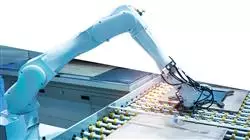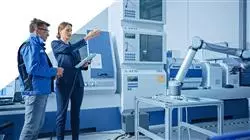University certificate
The world's largest faculty of engineering”
Introduction to the Program
Thanks to this Postgraduate diploma you will create and interpret plans of physical objects with the most modern digital tools"

With the rise of new technologies, the processes for drawing up plans have been affected. At the same time, most organizations have at their disposal various mechanisms to design graphic elements and achieve accuracy during manufacturing processes. Among its advantages is the contribution of greater efficiency, since possible faults can be detected and corrected before reaching the manufacturing stage. Therefore, it is not surprising that more and more companies are looking to integrate Mechanical Design professionals into their organization to interpret and create drawings using the most advanced digital tools.
In this context, TECH has an innovative program of studies to enable students to develop and interpret all types of plans. To achieve this, the curriculum addresses in detail the different motion transformation systems and CAD applications in engineering. It also emphasizes the finite element method so that graduates can successfully evaluate the feasibility of designs and projects. Thus, the students of this academic itinerary have a unique opportunity to broaden their skills in
Computer Aided Design and will be able to make the leap to the most prestigious companies in the sector.
On the other hand, the university program has a 100% online methodology so that the engineer can complete the program comfortably. You will only need a device with Internet access to deepen your knowledge in a sector that offers many job opportunities. In addition, the syllabus is based on the innovative Relearning method: a teaching system based on repetition, which ensures that the knowledge is acquired in a natural and progressive way, without the effort memorization.
You will master, through this program, motion transformation systems and CAD applications in engineering”
This Postgraduate diploma in Computer Assisted Mechanical Design contains the most complete and up-to-date program on the market. The most important features include:
- The development of case studies presented by Postgraduate Diploma experts in Computer Aided Mechanical Design
- The graphic, schematic and practical contents with which it is conceived provide cutting- Therapeutics and practical information on those disciplines that are essential for professional practice
- Practical exercises where the self-assessment process can be carried out to improve learning
- Its special emphasis on innovative methodologies
- Theoretical lessons, questions to the expert, debate forums on controversial topics, and individual reflection assignments
- Content that is accessible from any fixed or portable device with an Internet connection
You will delve into finite elements and their feasibility to develop successful Mechanical Designs"
The program’s teaching staff includes professionals from the sector who contribute their work experience to this training program, as well as renowned specialists from leading societies and prestigious universities.
The multimedia content, developed with the latest educational technology, will provide the professional with situated and contextual learning, i.e., a simulated environment that will provide immersive education programmed to learn in real situations.
This program is designed around Problem-Based Learning, whereby the professional must try to solve the different professional practice situations that arise during the academic year For this purpose, the students will be assisted by an innovative interactive video system created by renowned and experienced experts.
Expand your skills and become an expert in Computer Aided Mechanical Design"

You will have the support of a teaching team made up of professionals in the mechanical sector"
Why study at TECH?
TECH is the world’s largest online university. With an impressive catalog of more than 14,000 university programs available in 11 languages, it is positioned as a leader in employability, with a 99% job placement rate. In addition, it relies on an enormous faculty of more than 6,000 professors of the highest international renown.

Study at the world's largest online university and guarantee your professional success. The future starts at TECH”
The world’s best online university according to FORBES
The prestigious Forbes magazine, specialized in business and finance, has highlighted TECH as “the world's best online university” This is what they have recently stated in an article in their digital edition in which they echo the success story of this institution, “thanks to the academic offer it provides, the selection of its teaching staff, and an innovative learning method aimed at educating the professionals of the future”
A revolutionary study method, a cutting-edge faculty and a practical focus: the key to TECH's success.
The most complete study plans on the university scene
TECH offers the most complete study plans on the university scene, with syllabuses that cover fundamental concepts and, at the same time, the main scientific advances in their specific scientific areas. In addition, these programs are continuously being updated to guarantee students the academic vanguard and the most in-demand professional skills. In this way, the university's qualifications provide its graduates with a significant advantage to propel their careers to success.
TECH offers the most comprehensive and intensive study plans on the current university scene.
A world-class teaching staff
TECH's teaching staff is made up of more than 6,000 professors with the highest international recognition. Professors, researchers and top executives of multinational companies, including Isaiah Covington, performance coach of the Boston Celtics; Magda Romanska, principal investigator at Harvard MetaLAB; Ignacio Wistumba, chairman of the department of translational molecular pathology at MD Anderson Cancer Center; and D.W. Pine, creative director of TIME magazine, among others.
Internationally renowned experts, specialized in different branches of Health, Technology, Communication and Business, form part of the TECH faculty.
A unique learning method
TECH is the first university to use Relearning in all its programs. It is the best online learning methodology, accredited with international teaching quality certifications, provided by prestigious educational agencies. In addition, this disruptive educational model is complemented with the “Case Method”, thereby setting up a unique online teaching strategy. Innovative teaching resources are also implemented, including detailed videos, infographics and interactive summaries.
TECH combines Relearning and the Case Method in all its university programs to guarantee excellent theoretical and practical learning, studying whenever and wherever you want.
The world's largest online university
TECH is the world’s largest online university. We are the largest educational institution, with the best and widest online educational catalog, one hundred percent online and covering the vast majority of areas of knowledge. We offer a large selection of our own degrees and accredited online undergraduate and postgraduate degrees. In total, more than 14,000 university degrees, in eleven different languages, make us the largest educational largest in the world.
TECH has the world's most extensive catalog of academic and official programs, available in more than 11 languages.
Google Premier Partner
The American technology giant has awarded TECH the Google Google Premier Partner badge. This award, which is only available to 3% of the world's companies, highlights the efficient, flexible and tailored experience that this university provides to students. The recognition as a Google Premier Partner not only accredits the maximum rigor, performance and investment in TECH's digital infrastructures, but also places this university as one of the world's leading technology companies.
Google has positioned TECH in the top 3% of the world's most important technology companies by awarding it its Google Premier Partner badge.
The official online university of the NBA
TECH is the official online university of the NBA. Thanks to our agreement with the biggest league in basketball, we offer our students exclusive university programs, as well as a wide variety of educational resources focused on the business of the league and other areas of the sports industry. Each program is made up of a uniquely designed syllabus and features exceptional guest hosts: professionals with a distinguished sports background who will offer their expertise on the most relevant topics.
TECH has been selected by the NBA, the world's top basketball league, as its official online university.
The top-rated university by its students
Students have positioned TECH as the world's top-rated university on the main review websites, with a highest rating of 4.9 out of 5, obtained from more than 1,000 reviews. These results consolidate TECH as the benchmark university institution at an international level, reflecting the excellence and positive impact of its educational model.” reflecting the excellence and positive impact of its educational model.”
TECH is the world’s top-rated university by its students.
Leaders in employability
TECH has managed to become the leading university in employability. 99% of its students obtain jobs in the academic field they have studied, within one year of completing any of the university's programs. A similar number achieve immediate career enhancement. All this thanks to a study methodology that bases its effectiveness on the acquisition of practical skills, which are absolutely necessary for professional development.
99% of TECH graduates find a job within a year of completing their studies.
Postgraduate Diploma in Computer Aided Mechanical Design
Do you want to explore a career field that allows you to create accurate and efficient projects? TECH Global University's College of Engineering offers you an exceptional opportunity with its Postgraduate Diploma in Computer Aided Mechanical Design, taught in an online mode. This program, backed by one of the most recognized academic institutions, will provide you with the necessary skills to excel in the competitive field of design. The teaching team, made up of professionals with extensive industry experience, will guide you every step of the way, ensuring that you acquire solid, up-to-date knowledge. During the program, you will explore a wide range of topics, from fundamental concepts to advanced techniques in computer-aided design. You will learn how to use cutting-edge software tools that are essential in the industry, enabling you to create accurate and efficient drawings.
Master the field of engineering with our faculty
Studying with us is a unique opportunity to broaden your horizon and access an ever-growing network of contacts. The combination of academic excellence and the flexibility of online education gives you the freedom to tailor your studies to your schedule. The goal of this program is to prepare you to meet today's mechanical design challenges, ensuring that upon completion of the Postgraduate Certificate, you will apply your knowledge effectively in professional environments. Upon successful completion of the program, you will receive a nationally and internationally recognized certificate, which will open doors to a wide range of career opportunities in engineering, manufacturing and design companies around the world. Are you ready to take a leap in your career and become an expert in this sector? Take advantage of this incredible opportunity that TECH has for you! Enroll in the Postgraduate Diploma in Computer Aided Mechanical Design and prepare yourself for a successful future in the exciting world of design.
.







